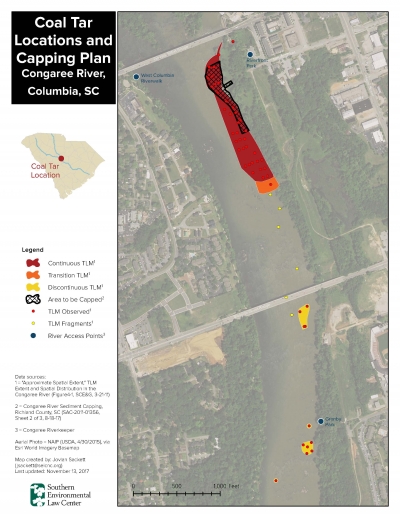Riverkeeper to sue utility, others to get coal tar out of South Carolina’s Congaree
Congaree Riverkeeper is taking the required first steps to sue over a utility’s broken promise to excavate acres of toxic coal tar coating the bottom of the historic waterway running through Columbia, S.C.
Represented by SELC, the riverkeeper this week filed notices of intent to sue South Carolina Electric and Gas, the U.S. Army Corps of Engineers, and the Environmental Protection Agency.

Coal Tar Coating the Congaree
The current cleanup proposal would only address a fraction of the coal tar pollution in the Congaree River.
SCE&G is responsible for the coal tar in the river and has backtracked on a pledge to clean it up. The Corps has agreed with SCE&G’s plan to lay a permeable sheet of fabric over the tar and contaminated sediments, and weigh down the fabric with concrete blocks. The fabric would cover only about one-third of the tar in the river.
The coal tar is spread across the river bottom for at least 10 acres near the Gervais Street Bridge. This stretch of the river is popular with tubers, kayakers and others wanting to enjoy the river snaking through the capital city’s downtown. The tar drained into the river decades ago from an industrial plant, and now SCE&G is responsible for it. When the tar was discovered in 2010, SCE&G committed to excavation, saying it was “the right thing to do.”
“SCE&G promised a cleanup, but what they are now offering is a cover-up,” said Bill Stangler, the Congaree Riverkeeper.
Coal tar is a carcinogen. It is a skin and eye irritant that is also dangerous to aquatic life.
A civil engineer who examined SCE&G documents said that SCE&G’s analysis of potential fixes for the coal tar was done in such a way that it steered the conclusion to the less expensive plan of shrouding the tar on the river bottom with fabric. The engineer wrote, “the cost, technical, and regulatory challenges of the removal remedy do not outweigh the benefit of removal and disposal of the contamination from the river and the removal option should be the first option considered.”
“SCEG hasn’t explained why the fabric liner is the best remedy for this site. Our expert says they can and should do better,” said Catherine Wannamaker, an SELC attorney. “State regulators must hold SCE&G to its past promises of properly cleaning up this mess.”
